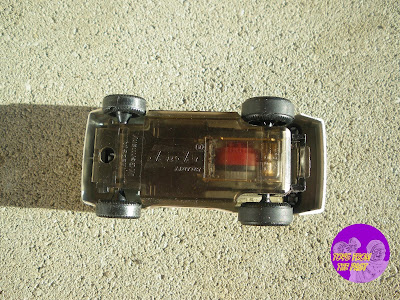
A couple of days ago, I came by the toy section of a great department store in my city. I was very surprised when I saw that Darda cars are still being sold. I didn’t know much about this brand until I found a couple of cars by this company in a flea market. At this moment I own three different models, and this are two of them.
Both cars are legends in the world of rallies, and have been reproduced many times as a toy. Darda cars are not specially detailed, since all cars are slightly deformed to make them look nicer. Darda’s biggest selling proposition/argument is not the accuracy of the model, but a rather powerful pullback motor, that was invented in 1970 by Helmut Darda. In addition to the pullback motor, special tracks could be bought with many curves, loopings, jumps and so on in which the cars could be played.
These cars were made between 1971 and 1992 in (West-)Germany, and since then in China. It is unclear if the company was sold by its original founder to an American company called Life-Like in 1984 or later, around 1990. This model belong to the first epoch of the toy company, 1971-1984, although I haven’t found exactly in which year it was built. In any case, the body of the car is made of plastic, while the models made before the 80s are often made in metal.
With the Renault 5 cast are over 20 different known versions and variations (different colours and decorations), all of them with the reference 1665 plus three numbers or two numbers and letter ‘w’ if it’s a promotional car made expressly to be given as a gift (w is for ‘Werbung’, german for publicity), but I’m not sure if this code has some “scientific” base (e.g. chronological order of release) or are just numbers given by collector websites for documentation purposes.
FACTS AND FIGURES:
- Name: R 5 TURBO (Ref. 1665-001) and LANCIA DELTA S4 (Ref. 1664-071)
- Scale: (estimated) 1:64
- Year: Around 1983
- Company: Darda (West-Germany)
- Size: approx. approx. 6 cm






Jeje precisamente hoy me adelantó uno por la autopista. Hacía años que no veía uno en vivo, qué bonito! ^^
ReplyDeleteRespecto al modelo las ruedas desproporcionadas estropean mucho su estética. Por lo demás es correcto sin más.
Cuando escribí el artículo pensé si debía incluir alguna referncia a los "superdeformed", pero no me pareció apropiado, porque no es lo mismo. Las ruedas han de ser grandes para que el motor transmita más velocidad al coche.
ReplyDeleteAyer a raíz de tu comentario estuve mirando en youtube un video de unos tal "Darda Brothers" que montan unas pistas brutales. Aunque el video tiene truco (está editado) es bastante espectacular. Pásate a verlo, por ejemplo, este: http://www.youtube.com/watch?v=M9a7ijMh338
Creo que la velocidad del video no está manipulada... son así de rápidos.
¡Impresionante! Que está editado está claro, lo difícil es diferenciar qué es real y qué está trucado. Me cuesta creer que ese motor de fricción aguante tanto tiempo.
ReplyDeleteLos he buscado por facebook y tienen una colección de pistas alucinantes. Deberías echarle un vistazo.
Y de paso me he encontrado esto que está de lo más interesante. Aunque el precio me da miedito.
http://youtu.be/1xujxUWs-rs
Ese es el truco, al coche le han dado cuerda varias veces, yo creo que más de 30 segundos no aguanta el coche. Lo más impresionante de ese video en concreto es en el parque infantil, cuando hace el looping sobre la tubería... El modelo de HotWheels es una excelente idea, una cámara a prueba de golpes para ponertela en el monopatín, bici o donde sea, no me explico cómo no se había comercializado antes.
ReplyDelete